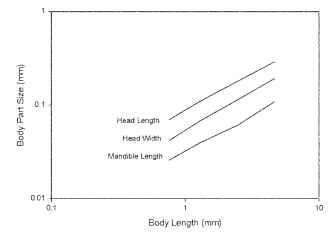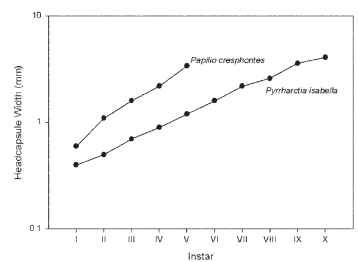The growth of individual insects proceeds in a progressive manner throughout the immature period of development, although the rate of growth can vary depending on a variety of factors such as molting frequency, temperature, and nutrition. Growth can be measured as an increase in biomass or body size, although biomass can be more variable than body size owing to differences in food and water intake. Growth usually is distinguished from development in that the latter refers to the various morphological and physiological changes that occur throughout the life span of an insect as it progresses toward maturation.
HOW INSECTS GROW
The limited ability of the rigid exoskeleton of insects to expand imposes a considerable constraint on individual growth resulting in the necessity to shed (i.e., to molt) the old exoskeleton, a process termed ecdysis, for growth to continue. Some insects (e.g., collembo-lans, diplurans, and thysanurans) exhibit indeterminate growth and continue to molt even after reaching the adult stage, although little if any increase in biomass occurs. In contrast, the majority of insects exhibit determinate growth in which both growth and molting cease upon reaching the reproductively mature last instar (i.e., the adult).
The pattern of individual growth differs depending on whether growth is measured as an increase in biomass or as an increase in body size. When measured as an increase in biomass, individual growth occurs between molts and is more or less continuous in most insects, although decreases in biomass often occur at the time of molting. When measured as an increase in body size, however, individual growth is largely dependent on the amount of sclerotization of the insect or of a particular body part. Membranous body parts, and those insects that are not highly sclerotized, can continuously increase in size between molts as folds in the cuticle expand, whereas insects or body parts that are more highly sclerotized increase in size immediately following each molt and exhibit a more discontinuous pattern.
Different body parts of insects may exhibit either isometric or allometric growth compared with the body as a whole. Isometric growth occurs when body parts grow at the same rate as the body as a whole, i.e., body length. Allometric growth occurs when body parts grow at rates different from that of the body and can be expressed as a power function of the form x = kya, where x is the dimension of the whole, y the dimension of the part, a the growth coefficient, and k a constant. Thus, a straight line results from a log-log plot of body part size versus body length (Fig. 1 ).

FIGURE 1 Allometric relationships between body part length and body length for P. albimanus (Diptera: Chironomidae) (Data from Ward and Cummins, 1978.)
INCREASES IN BIOMASS
Biomass increase of insects during development can be appreciable, with immature final instars weighing as much as 1000 or even 10,000 times greater than first instars. Changes in biomass can be expressed as either an absolute (weight/time) or a relative (weight/ weight/time) increase in biomass. Absolute growth usually is greatest in later instars and for the tobacco hornworm, Manduca sexta, larval weight increases as much as 90% (10-fold) in the final two instars. Similarly, 90% of the growth of larval Paratendipes albimanus (Diptera: Chironomidae) occurs in the final 10% of the life cycle. In contrast, relative growth rates normally decrease in later stages of development as the insect increases in size.
INCREASES IN BODY SIZE AND DYAR’S LAW
In 1890, H. G. Dyar noted that the head capsule widths of lepi-dopteran larvae followed a geometric progression in growth. During development of an immature insect, increases in body size occur in discrete steps, with highly sclerotized body parts exhibiting predictable and regular increases by a relatively constant factor, subsequently known as Dyar’s Law (or Rule). Although initially based on observations of lepidopteran larvae, Dyar’s Law has been applied to immature insects in general and refers to the geometric progression in the size of sclerotized structures that is constant throughout development. Dyar’s Law has been widely used in entomological studies to discern instars of immature insects and also has been used to predict the size of instars missing from samples. The ability to distinguish instars is crucial to accurately describe insect life histories and growth patterns and is widely used in secondary production studies.
Because membranous portions of the less-sclerotized cuticle (e.g., intersegmental membranes of the abdomen) allow the body to grow more or less continuously, overall body size is not considered a good indicator of instar. In addition, the increase in body size at each molt varies with different species and the growth of various body parts of many insects may differ from the growth rate of the body as a whole (i.e., allometric growth). In contrast, the rigid exoskeleton of immature insects prevents expansion and results in discontinuous growth of highly sclerotized cuticular parts (e.g., head capsule, legs). Thus, these structures increase in size incrementally in a stepwise manner following a molt. It is these distinct increases in the size of sclero-tized structures that allows for the distinguishing of different instars with little overlap occurring between size classes.
The publication of Dyar’s observations was in response to two previous papers that presented contradictory data concerning the number of molts in other species. Dyar studied the number of molts in 39 individuals of 28 species of caterpillars and chose the head capsule as the structure to measure for ease of measurement and because it was not subjected to growth during each stadium as was body length. The taxa chosen by Dyar ranged from 4 to 10 instars. Dyar calculated head-width ratios of successive instars and found that the progression was often nearly constant for a given species (mean = 1.5; range 1.3-1.7), what one would expect from a geometric progression. Dyar then calculated expected head capsule widths of each instar by multiplying the width of the final instar by this ratio and then back-calculating to the first instar. To test the applicability of the ratio, Dyar compared calculated head widths to those observed from reared specimens. Using this approach, it was possible to detect whether some instars had been missed or mismeasured. The most common method for detecting these problems is to plot the logarithm of the head capsule width measurement (or a measurement of another highly sclerotized structure) against the appropriate instar (Fig. 2). Conformity to Dyar’s Law results in a straight line the slope of which is constant for a given species. According to Dyar’s Law, deviations from a straight line indicate potentially missed instars or errors in measurement.
Although Dyar’s Law has been widely used in entomological studies, the progression in the size of sclerotized body parts is not

FIGURE 2 Conformity of head capsule width to Dyar’s Law for giant swallowtail (Papilio cresphontes, Lepidoptera: Papilionidae) and banded woollybear
always constant and can be influenced by abiotic and biotic factors such as temperature and food. In addition, apparent contradictions to Dyar’s Law occur when two requisite conditions are not met: (1) the number of instars is constant and (2) head capsule growth occurs only at ecdysis. Despite these constraints, approximately 80% of the entomological studies published from 1980 to 2007 that have examined the validity of Dyar’s observations provided support for his law.
There has been some disagreement as to whether Dyar should be credited with the findings of geometric progression in growth. In a paper published 4 years prior to Dyar’s article, Brooks reported that the total larval length of a species of crustacean stomatopod (Stomatopoda: Squillidae) sequentially increased in size by a factor of 1.25 at each molt. Brooks also noted, as did Dyar, that this relationship could be used to determine whether larval stages were missing from the series. Thus, Dyar’s Law may occasionally also be referred to as Brooks’ Law (or Rule) in the literature. It is likely that entomologists were unaware of Brooks’ observations because they were documented in a specialized publication on stomatopods.
EFFECTS OF TEMPERATURE ON INDIVIDUAL GROWTH
Because insects are ectotherms, temperature can have a profound impact on individual growth. In general, insect growth is correlated with environmental temperature; however, the strength of this relationship may be species- and habitat-specific. For example, many terrestrial insects exhibit little to no growth at low temperatures (0-4°C) because of either reduced feeding rates or overall low metabolic activity. Aquatic insects, in contrast, particularly those whose evolutionary ancestral habitat was in cold streams or lakes, can exhibit high growth rates during winter, assuming the presence of an adequate food supply. Although feeding rates of these insects may be low at reduced temperatures, basal metabolic needs also are low and result in the ability of the insect to direct more of the energy derived from ingestion to growth. The interactions between food quantity and quality and temperature are complex. In some streams, water temperature can influence the growth of microbial populations attached to detrital particles that are ingested by filter-feeding aquatic insects, and in turn, this can enhance their growth rate. This type of indirect control on aquatic insect growth and survivorship is difficult to separate from the direct effects of temperature on insect metabolism.
Elevated environmental temperatures also can result in either high or low larval growth rates because of the influence of temperature on larval ingestion, digestion, and development time. In general, larval ingestion and digestion are positively correlated with temperature and should result in increased growth rates at higher temperatures. The effect of temperature on growth rate, however, is confounded by an inverse relationship between ingestion rates and assimilation rates. In contrast, high temperatures can accelerate developmental time, resulting in the inability of larvae to maximize absolute growth rates.
EFFECTS OF NUTRITION ON INDIVIDUAL GROWTH
Individual growth of immature insects is strongly influenced by food availability, feeding selectivity, and food quality. Insect growth is often directly related to food availability, in that larval growth rates are highest in the presence of an abundant food supply. Because availability of food resources can vary temporally, growth responses also can be expected to vary throughout the year. For example, several species of stream chironomids (Diptera: Chironomidae) that feed primarily, but not exclusively, on attached algae, exhibit periods of maximal larval growth that coincide with times of the year when instream algal production is highest.
Feeding selectivity and food quality, however, also influence the relationship between growth and food availability. Even in the presence of an apparently abundant food supply, larval growth rates may be reduced if that food resource is not preferred or if it is of low quality or lacking essential nutrients. For example, the leaf-shredding crane fly, Tipula abdominalis. shows a strong preference for hickory, maple, and American chestnut leaves and a low preference for American beech, white oak, and red oak leaves. Larval growth rates are highest on the more-preferred leaf types and lowest on the less-preferred leaves. The higher growth rates on more-preferred leaves are not due to higher food conversion efficiencies, but rather result from increased consumption rates due to a more palatable food source.
Although food availability may not be a limiting factor for growth in some insects, food quality may impose a substantial constraint to larval growth. Differences in food quality also can affect larval growth rates and the ability to complete development and reproduce. Absolute and relative growth rates of the caddisfly Clistoronia mag-nifica (Trichoptera: Limnephilidae) reared on diets differing in quality were significantly higher on a diet rich in triglycerides (conditioned alder leaves plus whole wheat grains) compared with diets of conditioned alder leaves, conditioned alder leaves with a fatty acid mixture, conditioned alder leaves plus hyphomycete fungi, or hyphomycete fungi alone. In addition, only larvae fed the high-triglyceride diet successfully completed development and reproduced. Some insects, however, even in the absence of higher quality food, can maintain a relatively uniform growth rate throughout development by increasing ingestion rates of lower quality food.
